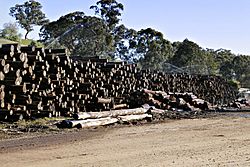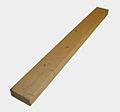Lumber facts for kids
Lumber (or timber) is wood that has been cut for use in building.
Contents
Dimensional lumber
Dimensional lumber is a term used in North America for lumber that is finished/planed and cut to standardized width and depth specified in inches.
Softwoods
| Softwood Dimensional Lumber Sizes | |||
|---|---|---|---|
| Nominal | Actual | Nominal | Actual |
| 1 × 2 | ¾″ × 1½″ (19×38 mm) | 2 × 2 | 1½″ × 1½″ (38×38 mm) |
| 1 × 3 | ¾″ × 2½″ (19×64 mm) | 2 × 3 | 1½″ × 2½″ (38×64 mm) |
| 1 × 4 | ¾″ × 3½″ (19×89 mm) | 2 × 4 | 1½″ × 3½″ (38×89 mm) |
| 1 × 6 | ¾″ × 5½″ (19×140 mm) | 2 × 6 | 1½″ × 5½″ (38×140 mm) |
| 1 × 8 | ¾″ × 7¼″ (19×184 mm) | 2 × 8 | 1½″ × 7¼″ (38×184 mm) |
| 1 × 10 | ¾″ × 9¼″ (19×235 Mm) | 2 × 10 | 1½″ × 9¼″ (38×235 mm) |
| 1 × 12 | ¾″ × 11¼″ (19×286 mm) | 2 × 12 | 1½″ × 11¼″ (38×286 mm) |
| 3 × 4 | 2½″ × 3½″ (64×89 mm) | 2 × 14 | 1½″ × 13¼″ (38×337 mm) |
| 4 × 4 | 3½″ × 3½″ (89×89 mm) | 6 × 6 | 5½″ × 5½″ (140×140 mm) |
| 4 × 6 | 3½″ × 5½″ (89×140 mm) | 8 × 8 | 7¼″ × 7¼″ (184×184 mm) |
Examples of common sizes are 2×4 (also two-by-four and other variants), 2×6, and 4×4. The length of a board is usually specified separately from the width and depth. It is thus possible to find 2×4s that are four, eight, or twelve feet in length. In the United States the standard lengths of lumber are 6, 8, 10, 12, 14, 16, 18, 20, 22, and 24 feet.
Non-North American sizes
| Examples of Dimensional Lumber Sizes (Softwood and Hardwood) | |||
|---|---|---|---|
| Inch name | Sawed | Swedish | Australian |
| 2 × 4 | 50 x 100 mm | 45 × 95 mm | 45 x 90 mm |
| 1 × 3 | 25 × 75 mm | 22 × 70 mm | 19 x 70 mm |
| 3 × 3 | 75 × 75 mm | 70 × 70 mm | 70 x 70 mm |
| 2 × 7 | 50 × 175 mm | 45 × 170 mm | Not used |
| 2 × 3 | 50 × 75 mm | 45 × 70 mm | 45 x 70 mm |
| 1 × 4 | 25 × 100 mm | 22 × 95 mm | 19 x 90 mm |
| 1 × 5 | 25 × 125 mm | 22 × 120 mm | 19 x 120 mm |
| 2 × 5 | 50 × 125 mm | 45 × 120 mm | 45 x 120 mm |
Outside North America sizes of timber vary slightly. Sizes are, in some cases, based on the imperial measurement and referred to as such; in other cases the sizes are too far removed from the imperial size to be referred to by imperial measurement. Lengths can be sold at every 300 mm (a metric approximation of 1'). Common sizes are similar to the North American equivalent; 2.4, 2.7, 3.0, 3.6, 4.2, 4.8, 5.4, 6.0. But also in running lengths, where each plank in a given packet is different, from 2500mm to 5500mm, though shorter and longer may be present.
Hardwoods
| Hardwood Dimensional Lumber Sizes | |||||||
|---|---|---|---|---|---|---|---|
| Nominal | Surfaced 1 Side (S1S) | Surfaced 2 sides (S2S) | |||||
| ⅜″ | ¼″ | 3/16″ | |||||
| ½″ | ⅜″ | 5/16″ | |||||
| ⅝″ | ½″ | 7/16″ | |||||
| ¾″ | ⅝″ | 9/16″ | |||||
| 1″ or 4/4 | ⅞″ | 13/16″ | |||||
| 1¼″ or 5/4 | 1⅛″ | 1-1/16″ | |||||
| 1½″ or 6/4 | 1⅜″ | 1-5/16″ | |||||
| 2″ or 8/4 | 1-13/16″ | 1¾″ | |||||
| 3″ or 12/4 | 2-13/16″ | 2¾″ | |||||
| 4″ or 16/4 | 3-13/16″ | 3¾″ | |||||
In North America sizes for dimensional lumber made from hardwoods varies from the sizes for softwoods. Boards are usually supplied in random widths and lengths of a specified thickness, and sold by the board-foot (144 cubic inches).
Engineered Lumber
Engineered lumber is lumber created by a manufacturer and designed for a certain structural purpose.
Related pages
Images for kids
-
Wood cut from Victorian Eucalyptus regnans
-
A sawmill with the floating logs in Kotka, Finland
See also
 In Spanish: Madera para la construcción para niños
In Spanish: Madera para la construcción para niños








